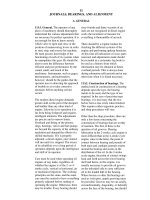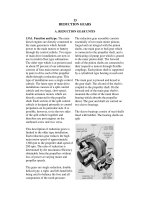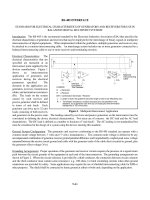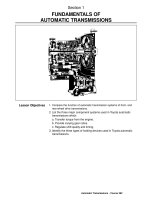Tài liệu Lightning protection syste pptx
Bạn đang xem bản rút gọn của tài liệu. Xem và tải ngay bản đầy đủ của tài liệu tại đây (131.13 KB, 5 trang )
Source:
Lightning protection system
A lightning protection system is a system designed to protect a structure from damage due
to lightning strikes by intercepting such strikes and safely passing their extremely high voltage
currents to "ground". Most lightning protection systems include a network of lightning rods,
metal conductors, and ground electrodes designed to provide a low resistance path to ground for
potential strikes.
Description
Lightning protection systems are used to lessen damage to structures by lightning strikes.
Lightning protection systems mitigate the fire hazard which lightning poses to structures. A
lightning protection system provides a low-impedance path for the lightning current to lessen the
heating effect of current flowing through flammable structural materials. Porous, water-saturated
materials may literally explode if their water content is flashed to steam by heat produced from
lightning current.
To appreciate the limitations of lightning protection systems, it is important to understand the
magnitude of lightning's energy. Because of the high electrical potential of lightning (often
exceeding 100 million volts and 40,000 amperes), and the very rapid rise time of a lighting
strike, no lightning protection system can guarantee absolute safety from lightning. Lightning
current will divide to follow every conductive path to ground, and even the divided current can
cause damage. Secondary "side-flashes" can be enough to ignite a fire, blow apart brick, stone, or
concrete, or injure occupants within a structure or building. However, the benefits of basic
lightning protection systems have been evident for well over a century.
[1]
The parts of a lightning protection system are air terminals (lightning rods or strike termination
devices), bonding conductors, ground terminals (ground or "earthing" rods, plates, or mesh), and
all of the connectors and supports to complete the system. The air terminals are typically
arranged at or along the upper points of a roof structure, and are electrically bonded together by
bonding conductors (called "down conductors" or "downleads"), which are connected by the
most direct route to one or more grounding or earthing terminals.
[2]
Connections to the earth
electrodes must not only have low resistance, but must have low self-inductance.
An example of a structure vulnerable to lightning is a wooden barn. When lightning strikes the
barn, the wooden structure and its contents, may be ignited by the heat generated by lightning
current conducted through parts of the structure. A basic lightning protection system would
provide a conductive path between an air terminal and earth, so that most of the lightning's
current will follow the path of the lightning protection system, with substantially less current
traveling through flammable materials.
Originally, scientists believed that such a lightning protection system of air terminals and
"downleads" directed the current of the lightning down into the earth to be "dissipated".
However, high speed photography has clearly demonstrated that lightning is actually composed
of both a cloud component and an oppositely charged ground component. During "cloud-to-
ground" lightning, these oppositely charged components usually "meet" somewhere in the
atmosphere well above the earth to equalize previously unbalanced charges. The heat generated
as this electrical current flows through flammable materials is the hazard which lightning
protection systems attempt to mitigate by providing a low-resistance path for the lightning
Generated by Foxit PDF Creator © Foxit Software
For evaluation only.
circuit. No lightning protection system can be relied upon to "contain" or "control" lightning
completely (nor thus far, to prevent lightning strikes), but they do seem to help immensely on
most occasions of lightning strikes.
Steel framed structures can bond the structural members to earth to provide lighting protection.
A metal flagpole with its foundation in the earth is its own extremely simple lightning protection
system. However, a flag flying from the pole during a lightning strike may be completely
incinerated.
In overhead transmission lines, a ground conductor may also be the top most wire on pylons,
poles, or towers. This ground conductor is intended to protect the power conductors from
lightning strikes. These conductors are connected to earth either through the metal structure of a
pole or tower, or by additional ground electrodes installed at regular intervals along the line. As a
general rule, overhead power lines with voltages below 50 kV do not have a ground conductor,
but most lines carrying more than 50 kV do. An over head transmission line may have two
overhead ground conductors. The ground conductor cable may also support fibreoptic cables for
data transmission ( see OPGW).
The majority of lightning protection systems in use today are of the traditional Franklin design.
[3]
The fundamental principle used in Franklin-type lightning protections systems is to provide a
sufficiently low impedance path for the lightning to travel through to reach ground without
damaging the building.
[4]
This is accomplished by surrounding the building in a kind of Faraday
cage. A system of lightning protection conductors and lightning rods are installed on the roof of
the building to intercept any lightning before it strikes the building.
Non-traditional systems aim to provide the same or similar protection with fewer components.
Although some are sold and installed, no such system has demonstrated this ability. This
category can be further divided into improved lightning rods that claim an increased zone of
protection (and are otherwise similar to a Franklin-type system), and systems that claim to
eliminate lightning strikes altogether. The first subcategory includes early streamer emission
(ESE) systems, radioactive rod systems, and laser induced systems. An example of a system that
claims to eliminate lightning strikes is the charge transfer system (CTS).
Traditional System
The traditional Franklin type lightning protection system has 3 main parts.
The roof circuit
Interconnection to grounding electrodes
Grounding electrodes
[edit] Roof circuit
The roof circuit is composed of a system of copper or aluminum
[5]
lightning rods and cables on
or in the roof of a structure. These are arranged to provide a zone of protection around the
building. Lightning rods are typically installed around the perimeter of flat roofs, or along the
peaks of sloped roofs at intervals of 20ft (6.1m) or 25ft (7.6m),
[6]
depending on the height of the
rod. When a flat roof has dimensions greater than 50ft by 50ft (15m x 15m), additional lightning
Generated by Foxit PDF Creator © Foxit Software
For evaluation only.
rods will be installed in the middle of the roof at intervals of 50ft (15m) or less in a rectangular
grid pattern.
[7]
The currently accepted theory of lightning propagation is referred to as the "rolling sphere
method".
[8]
The basic premise of the rolling sphere method is that near ground level, lightning
has a strike distance of 150ft (46m). What this means is that given an imaginary sphere with a
radius of 150ft (46m), one can find the parts of a structure that are susceptible to a lightning
strike by rolling this sphere over the building at all possible positions. Any part of the building
that can be touched by this sphere is susceptible to a lightning strike. Any part of the building
that cannot be touched by the sphere is considered to be under a "zone of protection". Using this
method, a properly designed lightning protection system will have lightning rods installs such
that when the sphere is rolled over the building, no part of the building can be touched by the
sphere except the tips of the lightning rods. There is one common exception to this, though, as
the sides of very tall structures do not typically require lightning rods.
[4]
If one imagines the center of the sphere moving at a constant rate as it is rolled over the building,
the parts of the building that are in contact with the sphere the longest are those that are most
likely to be struck by lightning.
[4]
A typical example of a part of a building that would be a
higher risk would be the edge of the roof as the sphere rests on this longer than any flat portion
of the roof. This is a simple explanation of why more air lightning rods are required on peaks or
the edges of flat roofs than are required on the middle of flat roofs.
Additional precautions must be taken to prevent side-flashes between the lightning protection
system and conductive objects on or in a structure. The surge of current through a lightning
protection conductor creates a difference in electric potential or "voltage" between it and any
conductive objects near it. This difference can be large enough to allow current to jump to and
flow through such objects, possibly causing significant damage, especially to structures housing
flammable or explosive materials. The most effective way to prevent such damage is to establish
and maintain low resistance electrical continuity between the lightning protection system and any
objects susceptible to a side-flash, effectively reducing the difference in voltage to near zero.
Such "bonding" allows the voltage on a lightning protection conductor and any nearby
conductive objects to rise and fall in tandem, thereby eliminating any risk of a side-flash.
[9]
[edit] Interconnection to grounding electrodes
The roof circuit must be electrically continuous with some method of grounding. This is usually
accomplished in one of two ways. The first way is to use copper or aluminum cables to connect
the roof circuit to the grounding electrodes. Virtually all structures require two or more
connections from the roof to the ground.
[10]
If a structure's perimeter is greater than 76 m, the
structure will require a connection for every 20m of perimeter or fraction thereof.
[11]
For
example, a structure with a perimeter of 315ft (96m) will require 4 connections from the roof
circuit to the grounding electrodes.
The second method is to utilize the structural steel present in a structure to carry the lightning
current between the roof and the ground. When this method is used, more connections to the
grounding electrodes are usually required. The number of connections at roof level usually does
not change,
[12]
but the number of connections from the building steel to the grounding electrodes
should average no less than 1 connection for every 60ft (18.3m) of building perimeter.
[13]
Generated by Foxit PDF Creator © Foxit Software
For evaluation only.
[edit] Grounding electrodes
Proper grounding of a lightning protection system is critical for the protection of a structure.
Failure to provide sufficient grounding could result in the damage or loss of property and lives.
The most common methods for grounding a lightning protection system include ground rods,
ground plates, Ufer grounds or a ground ring (counterpoise).
[14]
In poor grounding conditions
such as rocky soil or shallow topsoil, additional grounding measures should be taken to ensure
adequate grounding for the system.
Non-traditional systems
A number of non-traditional systems have been proposed which aim to reduce the number of air
terminals required by a traditional Franklin-type system, thereby hopefully reducing the overall
cost of the protection system. These can be divided into two categories: systems that provide an
increased zone of protection around each air terminal, and systems that eliminate lightning
strikes altogether. These benefits are currently only claimed, and have not been substantiated by
testing.
[edit] Early streamer emission
Early streamer emission (ESE) lightning conductors were invented in the 1980s. They aim to
provide a much wider lightning protection area than traditional Franklin lightning rods. In the
practice that ESE devices of all types fail to meet their technical and performance claims and are
not better than Franklin lightning rod systems.
[edit] Radioactive rod systems
Radioactive rod systems' main differentiating feature from traditional Franklin type systems is
the use of radioactive materials in the lightning rods. The theory behind this is that the
radioactive properties of the rods can ionize the air around the rod sufficiently to increase the
likelihood of that rod being struck, rather than the building itself. This, in effect, would increase
the zone of protection provided by the lightning rod. Unfortunately, the efficacy of radioactive
lightning has been shown to be less than that of regular lightning rods, as the radioactive
materials are only able to ionize air around the lightning rod for a short distance that doesn't
positively affect the chance of being struck.
[15]
[edit] Laser induced systems
Laser induction of lightning strikes is currently being researched by scientists.
[16]
The main
principle of these systems is that a sufficiently powerful and properly tuned laser can ionize air
from the clouds to the ground level. This ionization reduces the breakdown voltage of the air and
provides a lower resistance path for the lightning to travel on. This acts like a lightning rod tall
enough to reach the clouds. So far, scientists have only been able to trigger lightning activity in
the clouds and have not been able to induce a cloud-to-ground strike.
[17]
[edit] Charge transfer systems
Charge transfer systems claim to eliminate the charge buildup on a structure by transferring it to
the surrounding area, thereby eliminating the potential for a lightning strike. This is the same
Generated by Foxit PDF Creator © Foxit Software
For evaluation only.
idea that prompted Benjamin Franklin to invent the lightning rod. The effectiveness of these
systems has been called into question recently as studies have failed to show any evidence for
any reduction of lightning strikes when compared to traditional Franklin systems.
[
Risk assessment
Some structures are inherently more or less at risk of being struck by lightning. The risk for a
structure is a function of the size (area) of a structure, the height, and the number of lightning
strikes per year per mi² for the region.
[19]
For example, a small building will be less likely to be
struck than a large one, and a building in an area with a high density of lightning strikes will be
more likely to be struck than one in an area with a low density of lightning strikes. The National
Fire Protection Agency provides a risk assessment worksheet in their lightning protection
standard.
[20]
Generated by Foxit PDF Creator © Foxit Software
For evaluation only.









